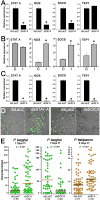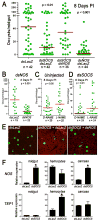The STAT pathway mediates late-phase immunity against Plasmodium in the mosquito Anopheles gambiae
- PMID: 19454353
- PMCID: PMC2701194
- DOI: 10.1016/j.chom.2009.04.003
The STAT pathway mediates late-phase immunity against Plasmodium in the mosquito Anopheles gambiae
Abstract
The STAT family of transcription factors activates expression of immune system genes in vertebrates. The ancestral STAT gene (AgSTAT-A) appears to have duplicated in the mosquito Anopheles gambiae, giving rise to a second intronless STAT gene (AgSTAT-B), which we show regulates AgSTAT-A expression in adult females. AgSTAT-A participates in the transcriptional activation of nitric oxide synthase (NOS) in response to bacterial and plasmodial infection. Activation of this pathway, however, is not essential for mosquitoes to survive a bacterial challenge. AgSTAT-A silencing reduces the number of early Plasmodium oocysts in the midgut, but nevertheless enhances the overall infection by increasing oocyst survival. Silencing of SOCS, a STAT suppressor, has the opposite effect, reducing Plasmodium infection by increasing NOS expression. Chemical inhibition of mosquito NOS activity after oocyte formation increases oocyte survival. Thus, the AgSTAT-A pathway mediates a late-phase antiplasmodial response that reduces oocyst survival in A. gambiae.
Figures






References
-
- Agaisse H, Perrimon N. The roles of JAK/STAT signaling in Drosophila immune responses. Immunol Rev. 2004;198:72–82. - PubMed
-
- Alavi Y, Arai M, Mendoza J, Tufet-Bayona M, Sinha R, Fowler K, Billker O, Franke-Fayard B, Janse CJ, Waters A, et al. The dynamics of interactions between Plasmodium and the mosquito: a study of the infectivity of Plasmodium berghei and Plasmodium gallinaceum, and their transmission by Anopheles stephensi, Anopheles gambiae and Aedes aegypti. Int J Parasitol. 2003;33:933–943. - PubMed
-
- Arbouzova NI, Zeidler MP. JAK/STAT signalling in Drosophila: insights into conserved regulatory and cellular functions. Development. 2006;133:2605–2616. - PubMed
Publication types
MeSH terms
Substances
Grants and funding
LinkOut - more resources
Full Text Sources
Other Literature Sources

